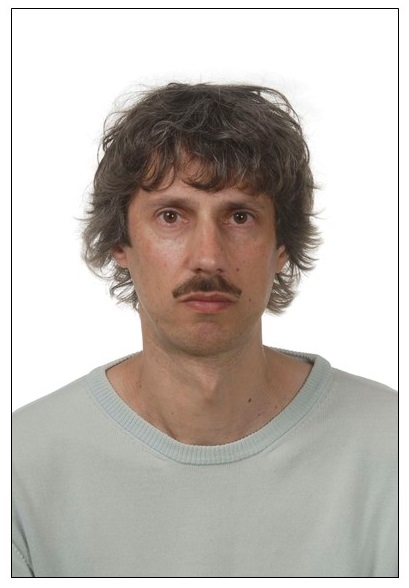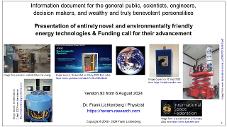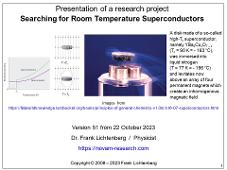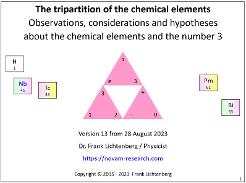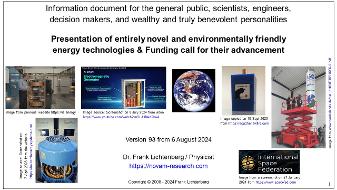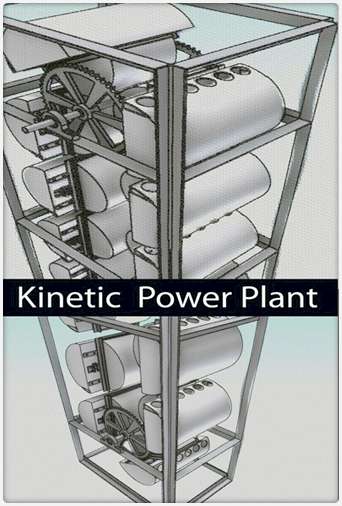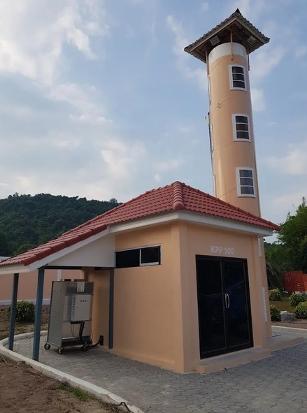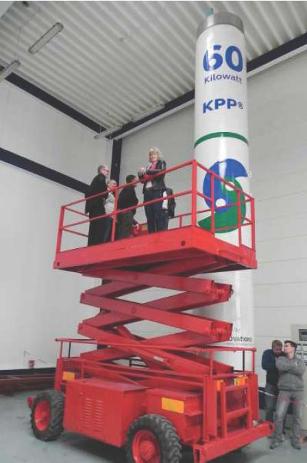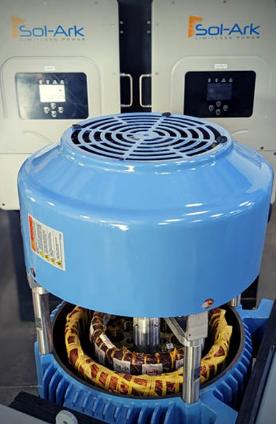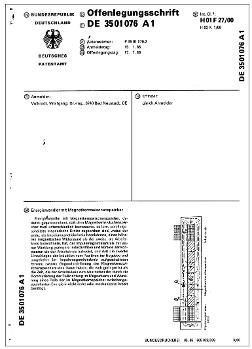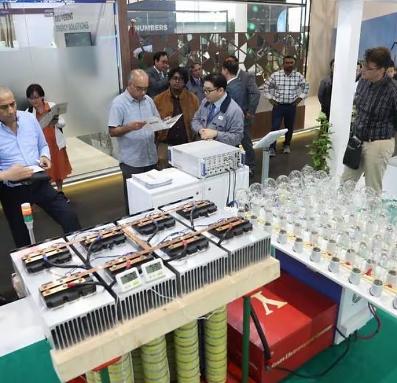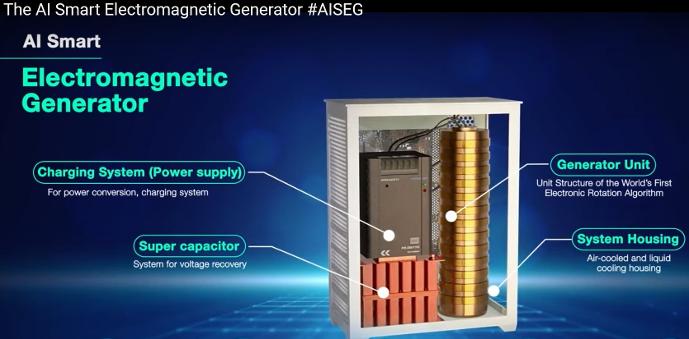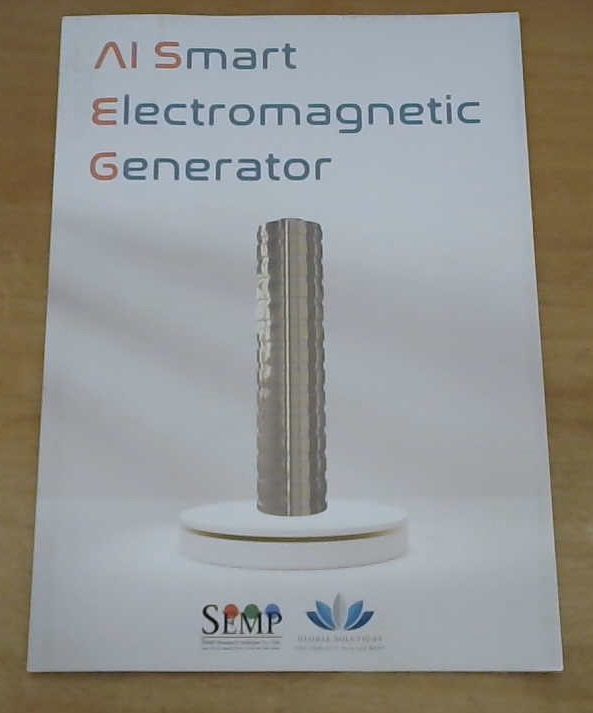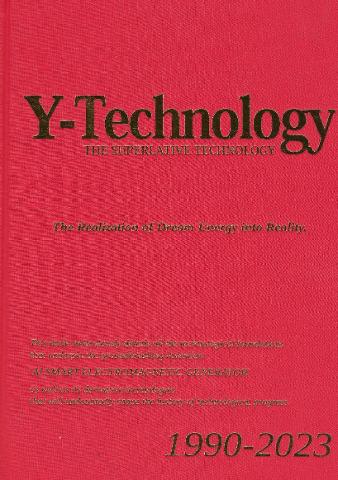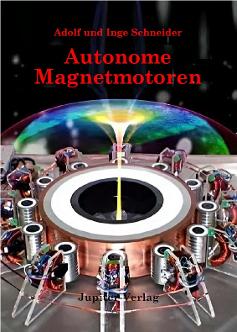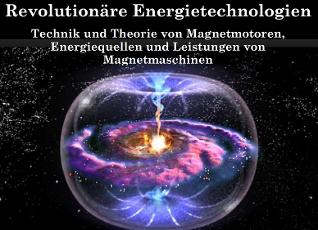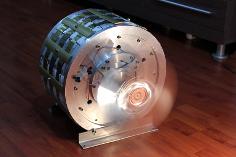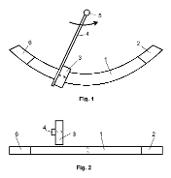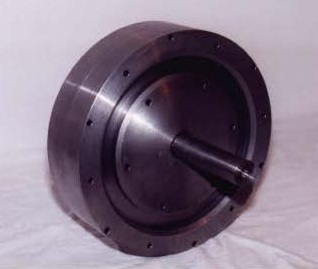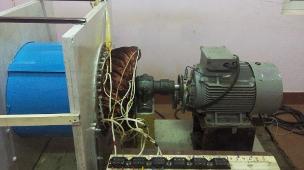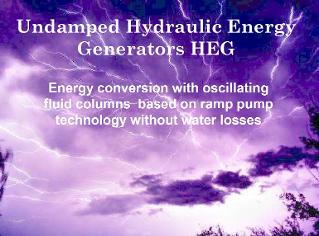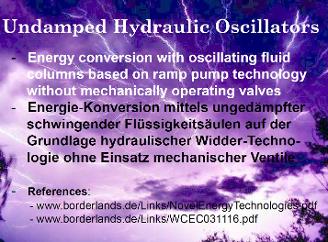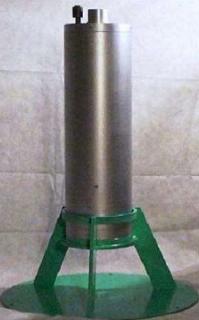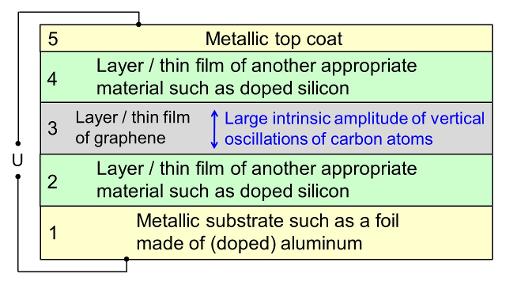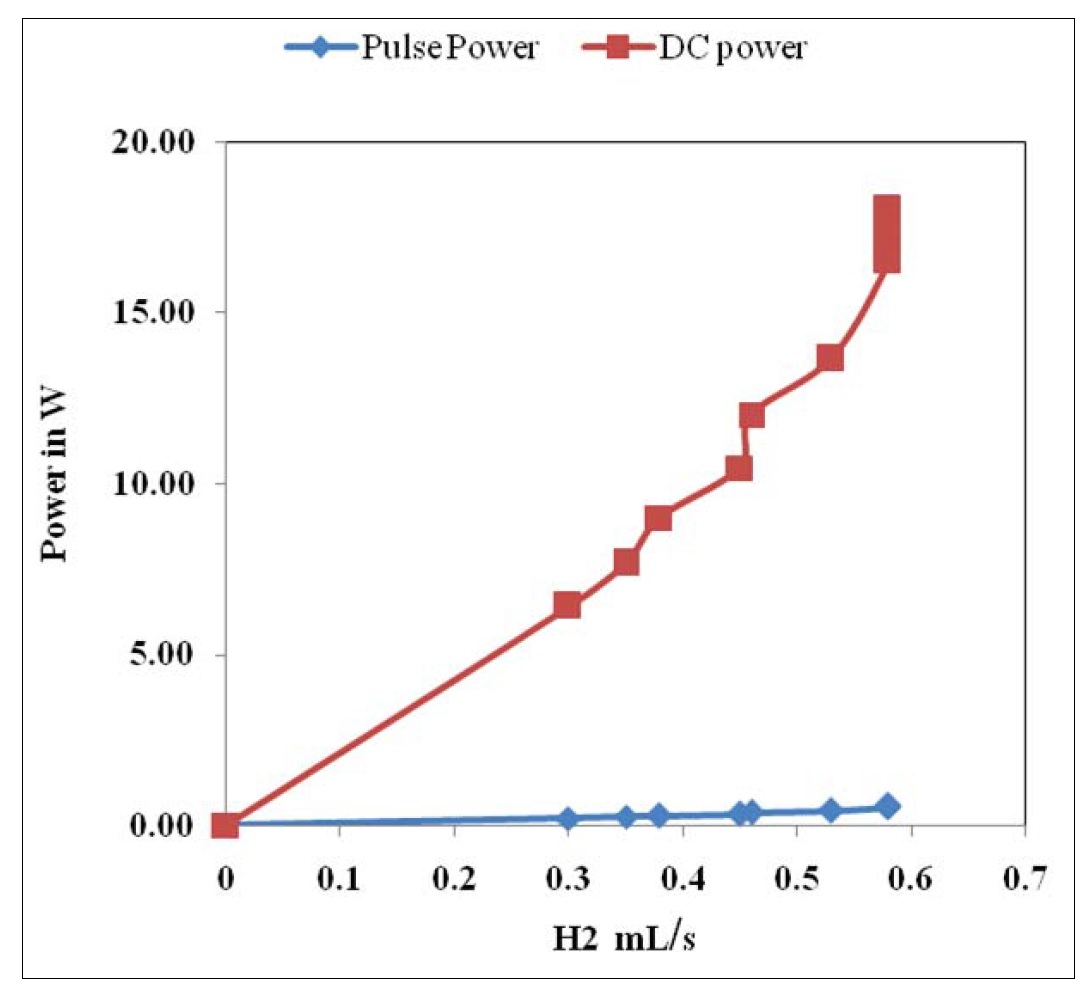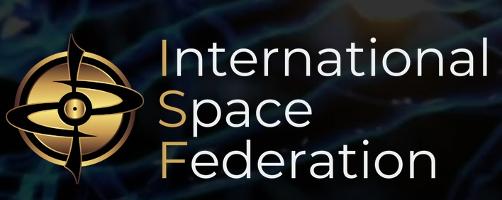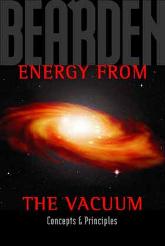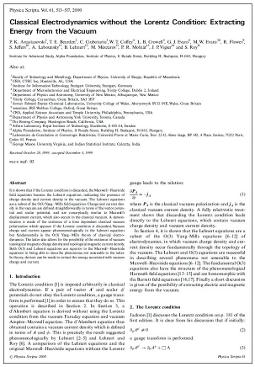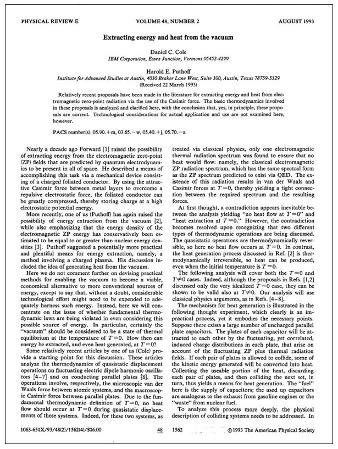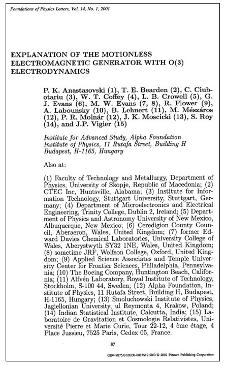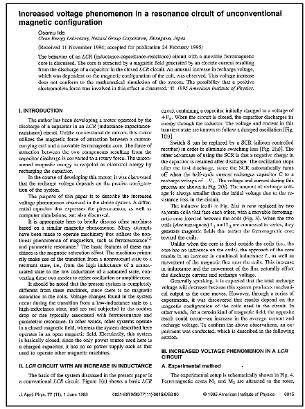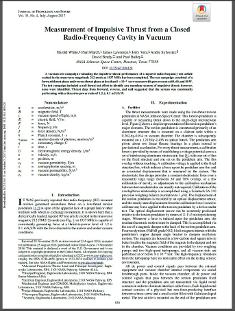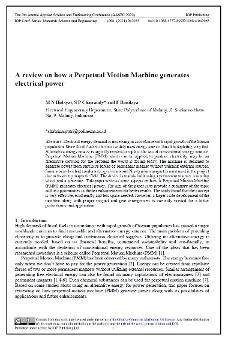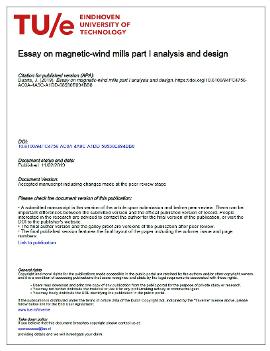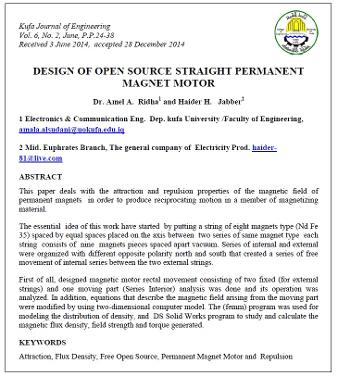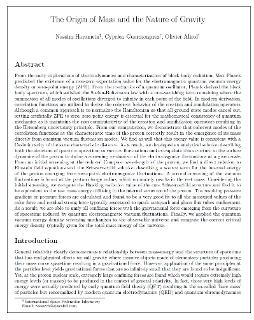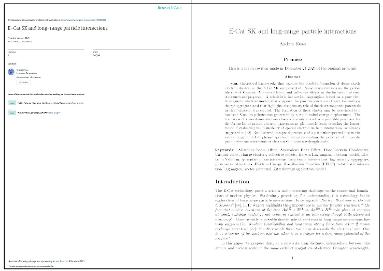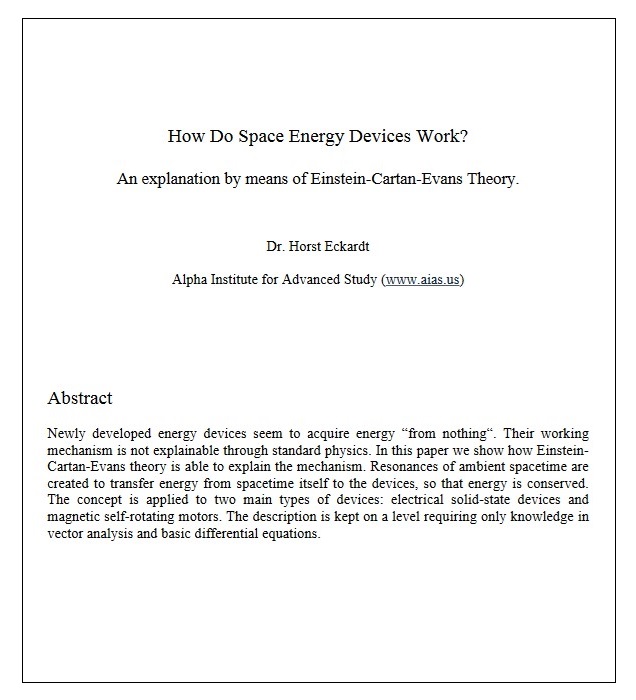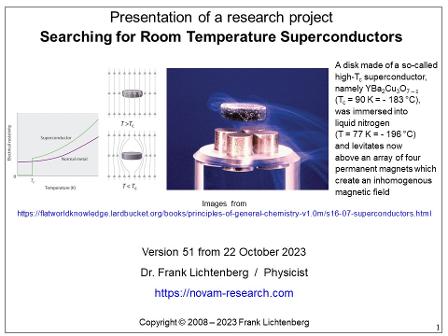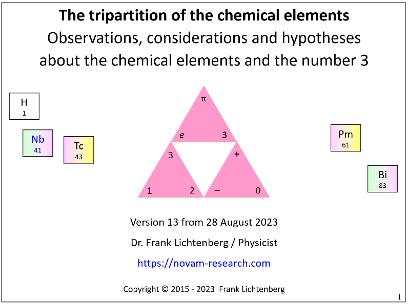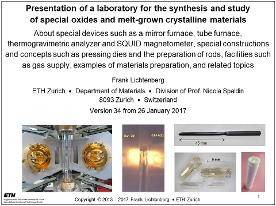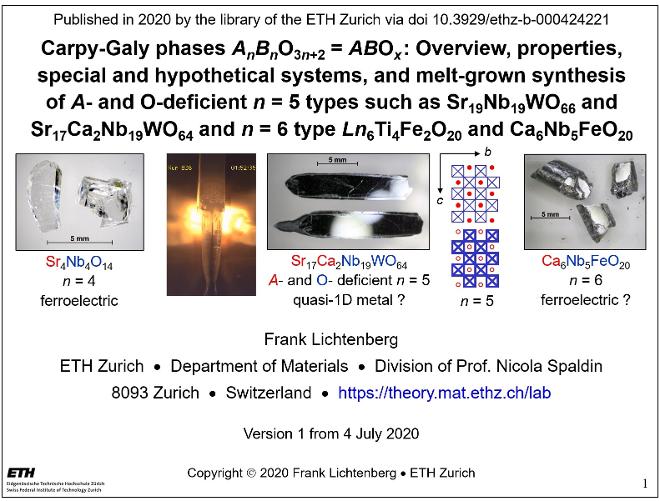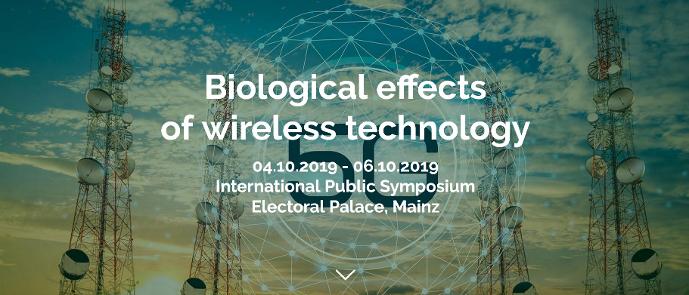Welcome to this website which is aiming to contribute to a progress and paradigm shift in physics, science, technology, awareness, and to an enjoyable evolution of mankind.
Topics on this home page further down:
- Entirely novel and environmentally friendly energy technologies, i.e. various self-running and zero emission motors / generators / power plants which tap an everywhere present form of energy which is called space energy, vacuum energy, zero-point energy, or ether energy
- Are they really genuine and why does it take so long to make them tangible and commercially available ?
- Kinetic power plants from the company Rosch Innovations
- ECAT technology / generators
- Magnet motor / generator systems from the Quantum Energy (Inductance Energy) Corporation
- Solid state power amplifiers from the company Holcomb Energy Systems
- Patent DE3501076A1 from 1986 by the former Siemens engineer Dr. Wolfgang Volkrodt
- Solid state generators from the SEMP Research Institute Co. Ltd.
- Various types of magnet motors & New German-language book "Autonome Magnetmotoren" (2024)
- Cryogenic magnet motor of Walter Thurner
- Tewari generator
- Generators based on autonomous hydraulic oscillations
- So-called neutrino voltaic
- Reid Cell & New book "Reid Cell" (2024)
- Water splitting by pulsed electrolysis
- International Space Federation & Their significant paper "The Origin of Mass and the Nature of Gravity" by N. Haramein, C. Guermonprez, and O. Alirol
- Tom Bearden: His website, motionless electromagnetic generator (MEG), and book "Energy from the Vacuum"
- Examples of papers including abstract about physical concepts for entirely novel energy and propulsion technologies
- Superconductivity
- The tripartition of the chemical elements
- Synthesis and study of special oxides
- Harmful effects of wireless communication technologies
Presentation about entirely novel and environmentally friendly energy technologies. Version 98 from 8 June 2025, 3 MB pdf
Presentation of a research project: Searching for Room Temperature Superconduc-tors. Version 51 from 22 October 2023, 11 MB pdf
Presentation about the tripartition of the chemical elements. Version 13 from 28 August 2023, 1 MB pdf
Entirely novel and environmentally friendly energy technologies
Information document for the general public, scientists, engineers, decision makers, and wealthy and truly benevolent personalities - Presentation about entirely novel and environmentally friendly energy technologies & Funding call for their advancement, 85 pages / slides, 3 MB pdf, version 98 from 8 June 2025
Entirely novel and environmentally friendly energy technologies
Last update 31 December 2023
Report about the self-running and zero emission power plants from the company Rosch Innovations
Abstract / Summary of the report: The company The company Rosch Innovations / Save The Planet AG
has developed so-called kinetic power plants (KPPs). These self-running
and zero emission power plants generate permanently usable electric
energy without any fuels, wind power or solar energy. Rosch offers via distribution partners industrial size power plants with an electric output power of 200 kW and 5, 40, and 100 MW as well as 1 MW and from 5 MW with fully scalable 500 kW modules . Distribution partners are e.g. the global engineering, procurment, and construction company Ki-TECH for the KPP technology and the German company E-Cat Deutschland GmbH .
An industrial size power plant at a publicly known and visitable
customer site does not yet exist. However, potential industrial
customers or potential licensees can visit and inspect an operating 100
kW and 500 kW power plant, provided that they provide a letter of intent and a proof of funds.
The 100 kW and 500 kW power plants are located at a Rosch site in
Thailand where they power that site and feed electricity into the grid, see the following video from 2022: https://www.youtube.com/watch?v=3IdNow8vZdg
. An inspection by an engineer team of the potential customer or potential
licensee allows a verification of the genuineness of the power plants and rule out possible objections such as a hidden power source. See, for example, the results of a technical examination of the 100 kW power plant in Thailand from 2018: http://borderlands.de/Links/KPP-Messung061218-Wunder+Holper.pdf . As already mentioned, an industrial size power plant at a publicly known and visitable
customer site does not yet exist. However, globally some power plants are under construction, see Ref. [7r] in the report, and there are some large projects which are in the planning stage, see e.g. the website https://wvge-me.com which presents projects and a roadmap for Montenegro and other Balkan states. Pictures on the right: Sketch of the buoyancy part of a kinetic power plant, the 100 kW demo plant in Thailand, and a former 60 kW pilot plant. An often
asked question is from where the generated energy comes from. The author
of this website assumes that this novel energy technology is
just one type of many possible types of systems which extract usable
energy from an everywhere present form of energy which is called space energy, vacuum energy, zero-point energy, or ether energy as presented in this information document . Papers about such an advanced and little-known approach are also
published in established science journals, see e.g. Refs. [11-14] in the report or the papers which are presented further down on this home page.
Sketch of the buoyancy part of a kinetic power plant (KPP). It comprises a water column which contains a chain drive, fillable containers which are attached at the chain drive, and a valve system which can fill the containers with air. Image from the Rosch Innovations website https://rosch.ag . Not shown in this picture are other parts of the KPP like an electric generator, an electrically-operated compressor, and a control unit.
Picture from the 100 kW demo plant in Thailand. Image copied via screenshot on 6 June 2022 from the Ki-TECH website https://www.ki-tech.global/home-login which comprises also other pictures
Picture from a 60 kW pilot plant from a publication in the NET Journal (ISSN 1420-9292), issue May / June 2016, page 9 (in German)
Image from https://ecatthenewfire.com
Report about the ECAT technology
Summary (short version): Websites: Official ECAT website https://ecatthenewfire.com and https://e-catworld.com . The image on the left from the official ECAT website displays a small and self-running electricity generator which is called E-Cat SKL NGU 10 W. Some of its specifications: DC output power / voltage 10 W / 12 V, diameter 6 cm, height 3 cm, weight 100 g, and expected operational lifespan more than 11 years. This and also generators with the following output power can be pre-ordered: 100 W, 1 kW, 2 kW, 3 kW, 5 kW, 10 kW, 1 MW, and custom size. The 5 kW generator, for example, has the dimensions 15 x 25 x 50 cm and a weight of 6 kg. Datasheet of the generators: https://ecatthenewfire.com/wp-content/uploads/2025/01/E-Cat-Power-NGU-DataSheet-2024-12-3.pdf . The production and delivery of some of the pre-ordered generators starts presumably in 2025, see also the two following videos from May 2025: https://www.youtube.com/watch?v=Cx3vw2hJLWs and https://www.youtube.com/watch?v=lvXhwMOdYIc . Some of the essential components of the ECAT electricity generators are a (small) vacuum tube which is filled with a low pressure inert gas, a magnet which influences the motion and spatial arrangement of electrons in the vacuum tube, and a special electronic control. It allows the extraction of usable energy from an everywhere present form of energy which is called zero-point energy, vacuum energy, space energy, or ether energy. Click here to view a Japanese patent application JP2022188336A (abstract also in English) by the inventor Andrea Rossi which was published on 21 December 2022
from the company Quantum Energy (Inductance Energy) Corporation
Dennis Danzik and co-workers from the former company Inductance Energy Corporation have developed a magnet motor, called Earth Engine, with a mechanical output power up to 25+ kW which can propel a mechanical device or an alternator with a maximal electrical output power in the range from 7 to 25 kW.

Image taken on 6 October 2019 from a video in the previous website https://ie.energy
The
magnet motors of the Inductance Energy Corporation comprise a flywheel,
a special asymmetric magnet array, a special triggering, and a control
unit. To
control the magnet motor an electrical input power of about 300 W is
required. If the magnet motor propels an alternator, then these about 300 W can be provided by the alternator. That results in
an overall self-running and zero emission magnet motor / generator system with a maximal electrical output power in the range from 7 to 25 kW.
In
the United States the Earth Engine is already in production on a small scale and in use at customers via leasing. The Inductance Energy Corporation has developed, manufactured, and installed 7 to 25 kW engines, capable of driving up to 4000 pounds
(1814 kg) of inertia and delivering in excess up to 25 kW electrical power.
In August 2019 Inge Schneider and Adolf Schneider and others have visited the company Inductance Energy Corporation in the United States. Running prototypes were inspected at two different locations, about 15 different devices in various stages of development were viewed, and several discussions with various people including the inventor Dennis Danzik took place. In September 2019 the author of this website attended a meeting in Switzerland where it was reported about it. Information about the visit in United States are presented on pages 25 - 53 in a German-language slide set (61 pages, 5 MB pdf) from a talk by Adolf Schneider about magnet motors on 3 October 2020 at a conference about novel energy technologies and related topics in Stuttgart in Germany.
Meanwhile the activities of the Inductance Energy Corporation are transferred to the company Quantum Energy Corporation. In their website https://qree.energy there is under Magnet a webpage called Magnetic Propulsion, https://qree.energy/magnetic_propulsion.html , which is still under construction. The former website https://ie.energy of the Inductance Energy Corporation is still existing but displays no content. The magnet motors were called Earth Engine and are meanwhile called Photon Engine or photon-driven magnetic propulsion engine. The author of this website would prefer another name without the term photon because the term photon appears here somewhat inappropriate and somewhat misleading.
YouTube videos with Dennis Danzik from the Quantum Energy Corporation about the magnet motor and self-running magnet motor / generator systems:
- https://www.youtube.com/watch?v=qsGvt-RRjuk from 14 July 2023
- https://www.youtube.com/watch?v=VRvJjQ2F68M from 21 July 2023
- https://www.youtube.com/watch?v=xur5GAQFUlA from 4 August 2023
- https://www.youtube.com/watch?v=4vIuMapXN8I from 24 August 2023
- https://www.youtube.com/watch?v=lvZTomsskJo from 13 September 2023
Related video from 26 October 2023: https://www.youtube.com/watch?v=LioFNn7KrjQ
The magnet motor and the self-running magnet motor / generator systems from Dennis Danzik are presented on pages 193 - 239 in the German-language book "Autonome Magnetmotoren" about self-running magnet motors by Adolf and Inge Schneider , first edition June 2024 , A5 type format (15 cm x 21 cm) , 470 pages , publisher Jupiter-Verlag , ISBN 978--3-906571-47-8: https://www.jupiter-verlag.ch/shop/detail_neu.php?artikel=160&fromMain=j . See also https://gehtanders.de/produkt/autonome-magnetmotoren (in German).
The
author of this website considers the fundamental operation principle of the
self-running magnet motor / generator systems from Dennis Danzik in the same way as that of other magnet motors and related concepts which are presented further below on this home page. A special arrangement of magnetic fields, special magnetic effects, and in this case also a special triggering results
macroscopically in an overall non-zero force and thus to a self-running
motion. Microscopically it taps via magnetic fields and the spin of the electrons an
everywhere present form of energy which is called space
energy, vacuum energy, ether energy, or space-time
energy. For further information about this energy form see this information document . See also papers which are presented further down on this home page.
Further references and information:
- Pages 3, 22, and 24 in the January / February 2023 issue of the NET-Journal (ISSN 1420-9292) (in German)
- German-language update on page 19 in the March / April 2021 issue of the NET-Journal (ISSN 1420-9292) (in German)
- Pages 25 - 53 in a German-language slide set (61 pages, 5 MB pdf) from a talk by Adolf Schneider about magnet motors on 3 October 2020 at a conference about novel energy technologies and related topics in Stuttgart in Germany. That slide set is also published in the website borderlands.de: www.borderlands.de/Links/Vortrag-Schneider-Magnetmotoren031020.pdf . See also page 22 in a German-language report in the November / December 2020 issue of the NET-Journal (ISSN 1420-9292) about the just mentioned conference (10 MB pdf, in German, see page 22): https://novam-research.com/resources/Kongress-Stuttgart_2-bis-4-Okt-2020_Bericht.pdf
- German-language report on pages 4 - 7 in the November / December 2019 issue of the NET-Journal (ISSN 1420-9292) (in German)
Entirely novel and environmentally friendly energy technologies
Website of the company Holcomb Energy Systems: https://holcombenergysystems.com
Dr. Robert Holcomb and co-workers from the company Holcomb Energy Systems have developed power-magnifying electromagnetic AC generators without moving parts. They generate at least a doubled output power with respect to the input power. They are called in-line power generators (ILPGs) and the already existing systems generate an output power in the range from 3 kW to 500 kW. The specified input and / or output power of various Holcomb Energy Systems was confirmed by established certification companies such as SGS. The technology of the Holcomb Energy Systems is protected by several patents and patent applications in many countries. See e.g. WO2023118149A1 (4 MB pdf) which was published on 29 June 2023 and a paper from Adolf Schneider in German but with many citations in English. Before market launch it appears desirable to perform a field test and study in more detail the dependence of the AC power amplification factor and other AC features like idle power, real power, and phase angle on various types of loads (ohmic, capacitive, and / or inductive). Also potential AC effects on the grid have to be considered.
Image source: Screenshot on 7 April 2023 from the website https://holcombenergysystems.com
Image source: Screenshot on 7 April 2023 from a video of Prof. Timothy Vaughan about novel energy technologies, namely https://www.youtube.com/watch?v=wvamIRUSbYE
During a German-language meeting of the Swiss Association for Space Energy (SVR) on 3 May 2024 in Zurich in Switzerland Adolf and Inge Schneider and others reported about a visit, measurements, and discussions in April
2024 at the company Holcomb Energy Systems in the United States. A German-language report about the visit, measurements, and discussions at the company Holcomb Energy Systems in the United States in April 2024 is published on pages 4 - 8 in the May / June 2024 issue of the German-language NET-Journal .
The Holcomb Energy Systems are presented on pages 253 - 280 in the German-language book "Autonome Magnetmotoren" about self-running magnet motors by Adolf and Inge Schneider , first edition June 2024 , A5 type format (15 cm x 21 cm) , 470 pages , publisher Jupiter-Verlag , ISBN 978--3-906571-47-8: https://www.jupiter-verlag.ch/shop/detail_neu.php?artikel=160&fromMain=j . See also https://gehtanders.de/produkt/autonome-magnetmotoren (in German).
On 14 October 2023 a congress about novel energy technologies took place in Zurich in Switzerland, see also the entry from 10 October 2023 under Events . Reinhard Wirth from the German-language blog https://gehtanders.de reported about his visit at the company Holcomb Energy Systems in the United States on 6 October 2023 [2-4], see also https://gehtanders.de/besuch-bei-holcomb-energy-systems . Ellen Sue Holcomb, Dr. Robert Holcomb, and an engineer from the company Holcomb Energy Systems joined via Zoom [2-4]. They presented their lab and their devices and some things about their research and development and reported about some ongoing and potential discussions and plans concerning further projects, series production, and marketing [2-4]. Their lecture was given in English and translated into German.
The
research and development of the Holcomb Energy Systems started with rotating systems / generators / motors and it was attempted to weaken, circumvent or release the counter-electromotive force or back emf. The latter act like a braking force which limits the efficiency of the system. During their studies several things were discovered, developed and implemented, e.g.
- so-called Mu Metal was used to shield some magnetic fields
- the moving rotor was replaced by an arrangement of coils which create a rotating magnetic field by switching them sequentially. Initially the sequential switching of the coils was performed with solid state relays. However, they became often damaged by high currents. Later another way without using solid state relays was found and implemented.
- the coils windings display a special curved geometry and were so far manufactured manually
- the used electrical steel was shaped into a specific geometry. The so-called electrical steel is a ferromagnetic material which is magnetically soft, i.e. it can be easily magnetized and demagnetized
- the B versus H curve of the electrical steel in the coils is used only in a specific section and during various meetings two different operating modes were mentioned, namely one without zero-crossing (and that would be remarkable) and another one with zero-crossing. B is the so-called magnetic flux density of the ferromagnetic material and H is an applied external magnetic field which is usually generated by a coil.
The operating principle of the Holcomb Energy Systems is related to a special magnetic
effect which is described in the patent DE3501076A1 from the former Siemens engineer Dr. Wolfgang Volkrodt, namely that the energy which is stored in a
ferromagnetic material after its magnetization is significantly larger
than the energy which was required to magnetize the ferromagnetic
material. The patent DE3501076A1 is presented further down on this home page. Even if a partial connection between the Holcomb Energy Systems and Dr. Wolfgang Volkrodt's patent DE3501076A1 is more or less obvious, the outlined development of the Holcomb Energy Systems and their own patents and patent applications indicate that Dr. Robert Holcomb and his co-workers had an independent approach.
The author of this website considers the fundamental operation principle of the Holcomb Energy Systems in the same way as for other self-running or power-amplifying magnetic or electromagnetic systems. A special arrangement of magnetic fields and special magnetic effects result macroscopically in an overall non-zero force and thus to a self-running motion or in an electric output power which is significantly larger than the electric input power. The latter allows also the construction of a self-running generator. Microscopically it taps via magnetic fields and the underlying spin of the electrons an everywhere present form of energy which is called space energy, vacuum energy, ether energy, or space-time energy. For further information about this energy form see this information document . See also papers which are presented further down on this home page.
The power-amplifying AC generators allow also the construction of a self-running or stand-alone generator system, namely by returning a part of the AC output power into the input of the AC power amplifier. The construction of a working self-running 15 kW generator system was already implemented in the lab of the company Holcomb Energy Systems. To decouple the AC input of the AC power amplifier from its AC output an AC / DC converter, a battery, and a DC / AC converter was used. However, the used type of battery became too hot and for a reliable and safe operation a proper energy storage subsystem is required.
References and further information:
[1] Report and presentation about a visit, measurements, and discussions in April 2024 at the company Holcomb Energy Systems in United States during a German-language meeting of the Swiss Association for Space Energy (SVR) on 3 May 2024 in Zurich in Switzerland. See also the entry from 15 April 2024 under Events (note that there are two entries from 15 April 2024)
[2] German-language reports and information in the German-language NET-Journal (ISSN 1420-9292):
- [2-5] Pages 4 - 8 in the May / June 2024 issue
- [2-4] Pages 16 - 18 in the November / December 2023 issue which are part of a German-language report about a German-language congress about novel energy
technologies in Zurich in Switzerland on 14 October 2023
- [2-3] Pages 15 - 17 and 19 - 21 and also 11 - 15 in the September / October 2023 issue (in German)
- [2-2] Pages 16 - 18 in the July / August 2023 issue which are part of a German-language report about a German-language congress about novel energy technologies and related topics in Stuttgart in Germany on 17 and 18 June 2023 (in German): http://www.borderlands.de/net_pdf/NET0723S9-33.pdf . On 17 June 2023 Prof. Timothy Vaughan and Ellen Sue Holcomb & Dr. Robert Holcomb gave a presentation. Their lecture was given in English and translated into German. Prof. Timothy Vaughan was personally there and Ellen Sue & Dr. Robert Holcomb joined via Zoom [1-2]
- [2-1] Pages 4 - 7 in the May / June 2023 issue (in German): http://www.borderlands.de/net_pdf/NET0523S4-7.pdf
[3] The company Astra Energy Inc. promotes the Holcomb Energy Systems and there is an article in the Financial Times about it which was published on 4 October 2023: https://markets.ft.com/data/announce/detail?dockey=1330-8943368en-4SP7AIOUBDOC2JOC2UTLVRC3FL or download that article as pdf from this website: https://novam-research.com/resources/Astra-Energy-Inc-Announces-Strategic-Partnership-with-Sustainable-Energy-Technologies-Inc_Financial-Times_4-Oct-2023.pdf
[4] Zoom meeting with Ellen Sue Holcomb and Dr. Robert Holcomb during a meeting of the Swiss Association for Space Energy (SVR) on 18 August 2023 in Zurich in Switzerland
[5] Zoom meeting with Prof. Timothy Vaughan about the Holcomb Energy Systems during a meeting of the Swiss Association for Space Energy (SVR) on 28 April 2023 in Zurich in Switzerland
[6] German-language presentation from Adolf Schneider about the Holcomb Energy Systems: http://www.borderlands.de/Links/Holcomb-Energy-System.pdf
[7] About the Holcomb Energy Systems (HES) In-Line Power Generator (ILPG): http://www.borderlands.de/Links/Intro_to_ILPG.pdf
[8] German-language considerations by Adolf Schneider about the energy / power amplification of the Holcomb Energy Systems: http://www.borderlands.de/Links/Holcomb-Energie.pdf
[9] Interview with Robert Holcomb from April 2022 - Green Tech: Dr Robert Holcomb of Holcomb Energy Systems On How Their Technology Will Make An Important Positive Impact On The Environment (in English and translated into German): http://www.borderlands.de/Links/Interview%20mit%20Green%20Tec.pdf
[10] List with links to many videos about the Holcomb Energy Systems: http://www.borderlands.de/Links/Holcomb-Filme.pdf
[11] Video from Prof. Timothy Vaughan about entirely novel energy technologies which are based on special magnetic effects and the electron spin: https://www.youtube.com/watch?v=wvamIRUSbYE . Keywords: Inventions, conventional and unconventional energy technologies, various inventors / researchers / scientists and their unconventional generators, Nikola Tesla, thermodynamics, magnetism, special magnetic effects, electron spin, Holcomb Energy Systems
For the English version of this patent see for example https://patents.google.com/patent/DE3501076A1/en . The text is a translation from the original German-language patent specification.
The original German-language patent specification including figures is for example available via this website: https://novam-research.com/resources/Patent-DE3501076A1.pdf
. According to the description the energy which is stored in a
ferromagnetic material after its magnetization is significantly larger
than the energy which is necessary to magnetize the ferromagnetic
material. This phenomenon can be used
to construct an electromagnetic device which provides at its output an
amount of usable electric energy or power which is significantly larger
than the energy or power which is fed into its input.
Citations from the English patent specification:
"
... Let us briefly summarize the current state of knowledge: The
necessary energy to magnetize or reverse magnetize a magnetic core store
is considerably smaller than the energy content that can be measured
afterwards in the permanent magnet ... Those to be expected according to
previous theories of energy technology Alternating hysteresis losses
are a multiple of what is actually required for reversal of
magnetization supplied electrical energy. The theory does not agree with
either the law of conservation of energy still match experimental
experience ...
... Up to now, conventional physics has only known the real components of electricity, magnetism and gravity. In order to interactions between the aforementioned quantities To be able to describe it in terms of vibrations and eddies, however, is more complex Sizes. According to more recent theories, imaginary quantities must also be in our space as are assumed to be present, from which, under certain conditions, a transformation is possible in forms of energy known to us ...
... According to the above hyperenergy theory, one understands by ferromagnetism the alignment of unpaired electrons (they are small hyperspace vortices) around it to establish the resulting magnetic vector field ...
... Apparatus and machines that use hyperspace as an energy source use are not perpetual motion machines, but rather energy converters in the conventional sense ..."
Last update 11 December 2024
The company SEMP Research Institute Co. Ltd. has developed power-amplifying and self-running electromagnetic generators without moving parts. They are called AISEGs which stands for Artificial Intelligence Smart Electromagnetic Generator.
Website of the company SEMP Research Institute Co. Ltd.: https://www.semp.or.kr/en
Short videos (a few minutes) about the AISEG: https://www.youtube.com/watch?v=SLJH8Ad2b44 from December 2023 and https://www.youtube.com/watch?v=VgsPcGvLyn4 from December 2018
AISEG at the Expo COP28 in Dubai in December 2023. On the right there are overall 60 lamps which can be used as load at the output of the AISEG. Image source: Screenshot on 7 July 2024 from https://www.semp.or.kr/en
The input of an AISEG is fed with a pulsed DC current and its output consists of an AC current. The AC output power is up to 17 times higher than the pulsed DC input power. A self-running operation becomes possible when a part of the AISEG output energy or power is fed into its input. It is elaborate to find the proper adjustments which allow a self-running operation. So far a self-running operation was tested up to 6 hours.
Image source: Screenshot on 8 July 2024 from video https://www.youtube.com/watch?v=SLJH8Ad2b44 . For a better readability the text of the 4 labels is repeated here: Charging System (Power supply) - For power conversion, charging system | Supercapacitor - System for voltage recovery | Generator Unit - Unit Structure of the World's First Electronic Rotation Algorithm | System Housing - Air cooled and liquid cooling housing. Note: So far a part of the AISEG output energy is fed via an AC / DC converter and a battery into its input. In future AISEG constructions it is intended to use the sketched supercapacitor instead of a battery.
On the right: Woo Hee Choi, co-founder and CEO of SEMP and main co-inventor of the AISEG, on 23 June 2024 at a German-language conference about novel energy technologies and related topics nearby
Stuttgart in Germany. Overall seven staff members from SEMP were there and presented a talk about the AISEG. There was a translation from Korean into English and from English into German. A
German-language report about (this conference and) the AISEG is published on pages (4) 21- 23 (25) in the July / August
2024 issue of the German-language NET Journal (ISSN 1420-9292).
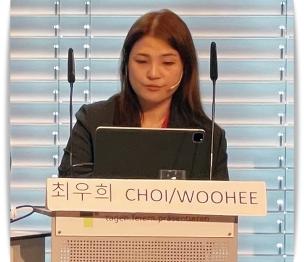
Image source: Newsletter from June 2024 from the Austrian Association for Space Energy (ÖVR)
In
August 2024 eleven people from Switzerland, Germany, and other
countries have visited SEMP and their staff members in South Korea and measurements were performed at an AISEG. In contrast to the latest AISEG which was presented in Dubai in December 2023 the available AISEG at SEMP in August 2024 was one of the previous models. At the demonstration of the available AISEG the battery became very hot and a reliable measurement of the input power was not possible. There are two German-language reports about the visit at SEMP in August 2024, namely
- on pages 4 - 14 in the September / October 2024 issue of the German-language NET Journal (ISSN 1420-9292) (in German): http://www.borderlands.de/net_pdf/NET0924S4-14.pdf
- in the blog gehtanders.de: https://gehtanders.de/semp-generator-die-reise-nach-korea (in German but that webpage is equipped with a Google translator)
In October 2024 four people, three from Switzerland and one from Germany, have visited SEMP and their staff members in South Korea. The results of this second visit at SEMP
- were presented at a German-language convention about novel energy technologies on 30 November 2024 in Zurich in Switzerland, see entry from 29 November 2024 under events and pages 10, 11, and 14 in a German-language report about that convention in the January / February
2025 issue of the German-language NET Journal (ISSN 1420-9292) (in
German)
- are published in a German-language report on pages 6 - 9 in the November / December 2024 issue of the German-language NET Journal (ISSN 1420-9292) (in German). In the same issue there are three further German-language reports about SEMP and the attempts to promote the AISEG, namely on pages 10 - 19
Summary and assessment of the current situation: The latest AISEG is still located and locked in Dubai because SEMP was after its demonstration at the Expo COP28 in December 2023 in Dubai not able to pay the stand fee. About 2 million USD are required to unleash that AISEG from Dubai and transport it back to SEMP in South Korea. SEMP and their staff members need further funding to develop / provide an AISEG prototype which allows a verifiable self-running operation with various types of loads (ohmic, capacitive, and / or inductive) over an extended period of time. A part of the AISEG output energy is so far fed via an AC / DC converter and a battery into the input of the AISEG. This feedback system, which decouples the input from the output, needs particular attention. It appears desirable to
- decrease the amount of energy which is branched off from the output and fed into the input
- replace the battery by supercapacitors or another appropriate system
The technology of the AISEG is scalable, i.e. generators with an output power from 5 kW to several 100 kW and more can be manufactured. The gravimetric power density of an AISEG is currently about 28 W / kg.
The operating principle of the AISEG is related to the AC power amplifiers from the company Holcomb Energy Systems and the patent DE3501076A1 from the former Siemens engineer Dr. Wolfgang Volkrodt. The latter is based on the observation hat the energy which is stored in a
ferromagnetic material after its magnetization is significantly larger
than the energy which was required to magnetize the ferromagnetic
material. The AC power amplifiers from the company Holcomb Energy Systems and the patent DE3501076A1 from Dr. Wolfgang Volkrodt are presented further up on this home page. Even if a partial connection between the AISEG and the Holcomb Energy Systems as well as Dr. Wolfgang Volkrodt's patent DE3501076A1 is more or less obvious, the AISEG design, patents, and patent applications indicate that the AISEG was developed in an independent manner. The AISEG comprises several distinct features such as the use of
- several coil towers whereby each tower consists of a vertical arrangement of alternating input and output coils which are magnetically connected by a common ferromagnetic core which
is magnetically soft (this arrangement corresponds to an open transformer)
- a pulsed DC current which is fed into the input coils to magnetize and demagnetize the ferromagnetic core material which is magnetically soft
- the so-called bandwagon effect which means that several adjacent coil towers couple and amplify each other their impact via their magnetic stray field
- artificial intelligence (AI) to create the control software of the generator
For the AISEG technology more than 70 patents were applied in 60 countries. A patent application which describes the fundamentals is for example the United States patent application publication US20230198368A1 which was published on 22 June 2023 and can be downloaded from this website: https://novam-research.com/resources/United-States-Patent-Application-Publication-US20230198368A1_2023.pdf
The author of this website considers the fundamental operation principle of an AISEG in the same way as for other self-running or power-amplifying magnetic or electromagnetic systems. A special arrangement of magnetic fields and special magnetic effects result macroscopically in an overall non-zero force and thus to a self-running motion or in an electric output power which is significantly larger than the electric input power. The latter allows also the construction of a self-running generator. Microscopically it taps via magnetic fields and the underlying spin of the electrons an everywhere present form of energy which is called space energy, vacuum energy, ether energy, or space-time energy. For further information about this energy form see this information document . See also papers which are presented further down on this home page.
The SEMP Research Institute Co. Ltd. and their AISEG is presented on pages 240 - 252 in the German-language book "Autonome Magnetmotoren" about self-running magnet motors by Adolf and Inge Schneider , first edition June 2024 , publisher Jupiter-Verlag , ISBN 978--3-906571-47-8: https://www.jupiter-verlag.ch/shop/detail_neu.php?artikel=160&fromMain=j . See also https://gehtanders.de/produkt/autonome-magnetmotoren (in German).
Further references and information:
A
report about the AISEG was presented during a German-language meeting
of the Swiss Association for Space Energy (SVR) on 19 July 2024 in
Zurich in Switzerland. German-language program of this meeting: https://svrswiss.org/pdfs_aso/Programm73.SVR-Meeting190724.pdf
A German-language report about the AISEG is published on pages 9 - 12 in the May / June 2024 issue in the German-language NET Journal (ISSN 1420-9292) (in German).
Book "Y-Technology". Paper size A4 and 1532 pages. Weight about 5 kg. It describes several inventions, especially the AISEG. It has no ISBN number and the publisher is the company SEMP Research Institute Co. Ltd. It can be requested and purchased via SEMP and its price is 1000 USD.
German-language book "Autonome Magnetmotoren" about self-running magnet motors by Adolf and Inge Schneider , first edition June 2024 , A5 type format (15 cm x 21 cm) , 470 pages , publisher Jupiter-Verlag , ISBN 978--3-906571-47-8: https://www.jupiter-verlag.ch/shop/detail_neu.php?artikel=160&fromMain=j . See also https://gehtanders.de/produkt/autonome-magnetmotoren (in German). Presented in this German-language book are also the self-running magnet motor / generator systems from the company Quantum Energy (Inductance Energy) Corporation, the solid state power amplifiers from the company Holcomb Energy Systems, the self-running solid state electromagnetic generator from the company SEMP Research Institute Co. Ltd., and the kinetic power plants from the company Rosch Innovations / Save The Planet AG which comprise specially modified electromagnetic generators. These systems are also presented on this home page and in this website.
German-language slide set of a talk by Adolf Schneider about magnet motors on 3 October 2020 at a conference about novel energy technologies and related topics in Stuttgart in Germany (61 slides or pages, 5 MB pdf). This slide set is also published in the website borderlands.de: www.borderlands.de/Links/Vortrag-Schneider-Magnetmotoren031020.pdf
Self-running magnet motor from the Turkish inventor Muammer Yildiz
Website: https://hmsbturk.com
A presentation event with a self-running permanent magnet motor took place on 17 and 18 December 2022 in Balcova at Izmir in Turkey. German-language reports about this event and related topics are published on pages 4 - 8 in the January / February 2023 issue and on pages 7 - 9 in the March / April 2023 issue of the NET-Journal (ISSN 1420-9292) (in German). A report, pictures, and videos about this event and related topics was presented during a German-language meeting of the Swiss Association for Space Energy (SVR) about novel energy technologies on 10 February 2023 in Zurich in Switzerland (in German): https://svrswiss.org/pdfs_aso/Programm64.SVR-Meeting100222.pdf .
Previous image from the website https://hmsbturk.com
A self-running prototype of the Yildiz Motor was presented and disassembled at the Eindhoven University of Technology in the Netherlands in April 2009 and at the University of Delft in the Netherlands in May 2010: https://www.youtube.com/watch?v=mHW6b1aFPfU
in
July 2019 the first part of an intended series of live-streamed tests
of a Yildiz Motor was performed [11]. The setup at the company D'Ambros in Belluno in Italy
comprised among various equipment a 7,5 kW Yildiz Motor which propels a
generator. At first the self-running and zero emission Yildiz Motor
operated well for about 7 hours and this can be already considered a
success. After about 7 hours a technical defect did arise and the Yildiz
Motor had to be stopped.
Several attempts to advance the Yildiz Motor towards commercial applications were not successful because discussions between Muammer Yildiz and potential investors did not result in mutual agreements.
The author of this website considers the fundamental operation principle of the Yildiz Magnet Motor and other self-running magnet motors in the following way: A special arrangement of magnetic fields results
macroscopically in an overall non-zero force and thus to a self-running
motion. Microscopically it taps via magnetic fields and the underlying spin of the electrons an everywhere present form of energy which is called space
energy, vacuum energy, ether energy, or space-time
energy. This energy form is presented in an information document about entirely novel and environmentally friendly energy technologies. See also some of the papers which are presented on this home page further down.
The Yildiz Motor comprises several
hundred permanent magnets. The self-running motion
comes about only if all permanent magnets are firmly and very precisely
fixed at specific positions. That seems to be not easy and quite
challenging. During operation the mechanical vibrations may change the
position of one or several permanent magnets if they are not very firmly
positioned. Furthermore, some permanent magnets are connected with a spring and their positions are periodically moved in a jumpy way. Such periodic mechanical concussions of the permanent magnets deteriorate stepwise their magnetic performance.
Other self-running magnet motors and related concepts
There are other magnet motor concepts which achieve a self-running motion with a significant less number of permanent magnets [1,2,3,4,5]. About such a concept was reported during a meeting of the Swiss Association for Space Energy (SVR) on 14 October 2022 in Zurich in Switzerland. A team of researchers and engineers have performed very extensive and detailed computational simulations by using the laws of conventional electrodynamics and the so-called finite element method. The results indicate a self-running motion with a system that comprises only 14 permanent magnets. A motor with a diameter of about 40 cm and a length of about 60 cm should generate a mechanical output power of about 20 kW. The intended manufacturing of such a system will reveal if the obtained computational results are correct. So far this project is not (yet) published but somewhat about it is presented in Ref. [1].
References, papers, presentations, and reports
[1] German-language report by Adolf Schneider about various magnet motor concepts on pages 35 - 38 in the November / December 2022 issue of the NET-Journal (ISSN 1420-9292) (in German)
[2] Paper "Essay on Magnetic-Wind Mills - Part 1: Analysis and Design" from 2019 by Dr.
J. L. Duarte from the Department of Electrical Engineeering of the
Eindhoven University of Technology in the Netherlands: https://doi.org/10.6100/94FC4756-AC0A-4A9C-A1DD-58530E694BB8 . A version of Part 2, namely that from 15 November 2022, can be downloaded from this website: https://novam-research.com/resources/Essay-on-Magnetic-Wind-Mills_Part2_J-L-Duarte_v4_15-Nov-2022.pdf
[3] Paper "Design and Simulation of Self-Running Magnetic Motor" from 2017 by Abdul Halim Ali and Ahmad Najmuddin Che Ismail: https://www.researchgate.net/publication/335257538 or download it as pdf from this website: https://novam-research.com/resources/Design-and-Simulation-of-Self-Running-Magnetic-Motor_A-H-Ali-and-A-N-C-Ismail_2017.pdf
[4] Paper "Design and Simulation of Free Energy Permanent Magnet Motor (FEPMM)" from 2016 by Amel Ridha: https://www.researchgate.net/publication/307513635
[5] The
following paper from 2015 presents in its introduction various types of
magnet motors and reports about an own concept:
Design of open source straight permanent magnet motor, Amel Ridha and
Haider H. Jabber, Kufa Journal of Engineering, Volume 6 (2015), pages 24 - 38: https://doi.org/10.30572/2018/KJE/621146 . Also published via https://www.researchgate.net/publication/307513641
[6] Two papers "Introducing the Yildiz Motor" and "Modeling the Yildiz Motor" from 2010 and 2012 by Dr.
J. L. Duarte from the Department of Electrical Engineeering of the
Eindhoven University of Technology in the Netherlands: https://novam-research.com/resources/Introducing-and-modeling-the-Yildiz-Motor_v01.pdf
[7] A review on how a Perpetual Motion Machine generates electrical power,
M. N. Hidayat, S. P. Chairandy, and F. Ronilaya, IOP Conference Series: Materials Science and Engineering 1098 (2021) 042063 (1 - 7)
https://doi.org/10.1088/1757-899X/1098/4/042063
[8] Updates about magnet motors are presented on page 14 in a German-language report in the November / December 2020 issue of the NET-Journal (ISSN 1420-9292) about a conference from 2 to 4 October 2020 in Stuttgart in Germany about novel energy technologies and related topics (10 MB pdf, in German, see page 14): https://novam-research.com/resources/Kongress-Stuttgart_2-bis-4-Okt-2020_Bericht.pdf
[9] German-language slide set (61 pages, 5 MB pdf) of a talk by Adolf Schneider about magnet motors on 3 October 2020 at a conference about novel energy technologies and related topics in Stuttgart in Germany . This slide set is also published in the website borderlands.de: www.borderlands.de/Links/Vortrag-Schneider-Magnetmotoren031020.pdf
[10] German-language report about the Yildiz Motor on page 20 in the September / October 2020 issue of the NET-Journal (ISSN 1420-9292) (in German)
[11] A German-language report about a test of a Yildiz Motor is published on pages 4 - 7 in the July / August 2019 issue of the NET-Journal (ISSN 1420-9292) (in German): http://www.borderlands.de/net_pdf/NET0719S4-7.pdf
[12] The Yildiz Motor is presented on pages 16 - 19 in a slide set (35 pages, 2 MB pdf) of a talk by Adolf Schneider about novel energy technologies on 3 November 2016 at the World Clean Energy Conference 2016 in Geneva in Switzerland
[13] The Yildiz Motor was presented at the 41th inventor fair in Geneva in Switzerland, see page 12 in the following German-language report in the May / June 2013 issue of the NET-Journal (in German): http://www.borderlands.de/net_pdf/NET0513S4-14.pdf
Please note: Walter Thurner died on 12 February 2021 and meanwhile his former German-language website www.walter-thurner.de no longer exists and his former German-language pdf document www.walter-thurner.de/magnet.pdf is no longer available via his former website. However, his original pdf document is available via this website: https://novam-research.com/resources/Walter-Thurner_Kryo-Magnet-Motor.pdf . The author of this website thanks Walter Thurner for his remarkable work and his former pdf document whose essential parts are presented in English in this report. A German-language obituary is published on pages 63 and 64 in the May / June 2021 issue of the German-language NET-Journal (ISSN 1420-9292).
Report about the self-running cryogenic magnet motor of Walter Thurner
This magnet motor represents a nice example of a self-running system which can generate
usable energy. Its operation principle appears fairly comprehensible. Once it is understood one has an idea how a self-running system can work concretely, at least at the macroscopic scale. It appears worthwhile and instructive to try to recreate this magnet motor and develop a system that limits and controls its speed of rotation.
Report about Paramahamsa Tewari, his reactionless electromagnetic generator, and his Space Vortex Theory
Presentation (40 pages, 3 MB pdf) from May 2021 by Adolf Schneider
about ram pumps and generators based on self-running hydraulic oscillations. It can be downloaded also via http://www.borderlands.de/Links/HEG-Presentation-English.pdf
German-language slide set (55 pages, 3 MB pdf) of a talk by Adolf Schneider
about ram pumps and generators based on self-running hydraulic oscillations on 4 October
2020 at a conference about novel energy technologies and related topics
in Stuttgart in Germany.
Report about self-running and zero emission generators based on autonomous hydraulic oscillations and the ram pump principle.
So far operating demonstration generators which can be viewed and inspected on request does not exist. Attempts to make such demonstration models available are stuck because of imposed sanctions against Russia. So far there are only undisclosed customers and they have not reported their experiences with their generator and their associated DC / DC converter and DC / AC converter. Therefore several items are not yet concretely known, namely the design of an appropriate DC / DC converter, the behavior of the generators and converters under various conditions such as a resistive, capacitive, and / or inductive load, and the power stability and safety over a long period of time.
Example of a self-running generator Type AR-500 (EGM-H-P-500-20)
Output power 500 kW
Output voltage 6 kV
Height 30 cm Diameter 14 cm
Weight 20 kg
Maximum tilt angle 60 degrees
Image and technical specifications from page 34 of a presentation (40 pages, 3 MB pdf) from May 2021 by Adolf Schneider about ram pumps and generators based on self-running hydraulic oscillations.
Entirely novel and environmentally friendly energy technologies
So-called neutrino voltaic / cells / technology - Self-running and zero emission electrical DC generators without moving parts from the company Neutrino
Last update 7 June 2025
Report about the so-called neutrino voltaic
Entirely novel and environmentally friendly energy technologies
Reid Cell or Crystal Cell
Last update 5 June 2025
The Reid Cell or Crystal Cell provides a small amount of electrical DC power of about 1 mW over a very long period of time, so far since 1998. This and some other features cannot be explained solely by conventional electrochemical effects. Video from 2023 about the Reid Cell or Crystal Cell by Eckhard Kantz and Marcus Reid: https://www.dailymotion.com/video/x93j7o4 . Websites: https://vakuumenergie.de and https://quantumpowermunich.de . For comments on the Reid Cell or Crystal Cell see https://quantumpowermunich.de/wp-content/uploads/2023/12/Comments-Reid-Cell.pdf and / or https://vakuumenergie.de/wp-content/uploads/2023/12/Comments-Reid-Cell.pdf
The Reid Cell or Crystal Cell represents an interesting topic for further research, development, and advancement, especially with respect to the origin of the electrical power and how the power can be increased.
A book about the Reid Cell or Crystal Cell is already available or coming soon:
- Title: Reid Cell
- Authors: Marcus Reid, Eckhard Kantz, and Dr. Nigel Deyer
For further information like front cover, back cover, foreword, and contents see https://quantumpowermunich.de/wp-content/uploads/2024/04/Marcus-CC-Innenseiten-Eriks-Edits.pdf and / or https://vakuumenergie.de/wp-content/uploads/2025/03/Marcus-CC-Innenseiten-book-prev.pdf
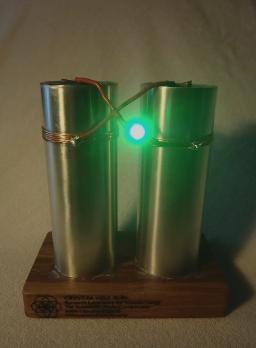
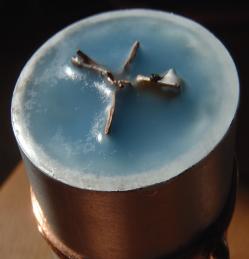
Image source: See for example Screenshot from former video https://www.dailymotion.com/video/x8lkslc from March 2024
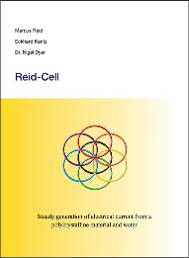
Image source: See for expample https://vakuumenergie.de
Entirely novel and environmentally friendly energy technologies
Water splitting by pulsed electrolysis
Last update 12 May 2023
The figure displays the effect of a conventional DC electrolysis and a pulsed electrolysis on the hydrogen production rate. Image source: Figure 6 in the paper C. H. Dharmaraj and S. AdishKumai, International Journal of Energy and Environment 3 (2012) 129 - 136
In established physics / chemistry / science it is assumed that the modulus of the energy which is required to split a water molecule (electrolytically) into hydrogen and oxygen is always equal to the modulus of the energy which is released when hydrogen and oxygen recombine into a water molecule. This is because the two hydrogen atoms and the one oxygen atom in a water molecule are bound together by electric or electromagnetic forces which are considered as so-called conservative force fields, i.e. a closed loop motion of a particle in such a force field can never result in a gain of usable energy.
However,
many researchers and inventors have claimed that under specific
conditions it is possible to split water into hydrogen and oxygen with
much less energy than usual. In this case usable energy can be generated
when the created hydrogen and oxygen recombine into water with a
release of the usual amount of energy.
The following work is a published example how water can be split into hydrogen and oxygen with much less energy than usual, namely by a special pulsed electrolysis:
Economical hydrogen production by electrolysis using nano pulsed DC C. H. Dharmaraj and S. AdishKumar , International Journal of Energy and Environment , Volume 3 (Issue 1), 2012, pages 129 - 136 , https://www.ijee.ieefoundation.org/vol3/issue1/IJEE_13_v3n1.pdf . or open or download this paper as pdf from this website.
The authors of this paper have not discussed the potential physics behind this remarkable phenomenon. The author of this website assumes that any physical process can be performed / modified / designed in such a way that it taps an everywhere present energy source which is called space energy, vacuum energy, ether energy, or space-time energy. For further information about this form of energy see this information document about entirely novel and environmentally friendly energy technologies. From this perspective it is assumed that a specifically pulsed electrolysis results somehow in an assisted water splitting where a large part of the required splitting energy is provided by an usable inflow of space / vacuum / ether / space-time energy.
Further related information: Adolf Schneider has prepared a German-language overview and compilation about various conventional and unconventional water splitting processes and their efficiency (in German): http://www.borderlands.de/Links/Wasserstoffherstellung.pdf
Advanced physics and entirely novel and environmentally friendly energy technologies
Image from a screenshot of https://www.spacefed.com on 21 January 2024
International Space Federation (ISF)
Last update 11 August 2024
Website: https://www.spacefed.com
YouTube channel: https://www.youtube.com/@intlspacefed
Swiss corporation with headquarters in Geneva and laboratories in France
Research and development in the field of quantum vacuum, gravity and unified physics which also includes entirely novel and environmentally friendly energy technologies. Research director is Nassim Haramein
Significant paper "The Origin of Mass and the Nature of Gravity" by Nassim Haramein, Cyprien Guermonprez, and Olivier Alirol - published on 26 September 2023 via zenodo.org: https://doi.org/10.5281/zenodo.10125315 . Abstract:
- From the early explorations of thermodynamics and characterization of black body radiation, Max Planck predicted the existence of a non-zero expectation value for the electromagnetic quantum vacuum energy density or zero-point energy (ZPE). From the mechanics of a quantum oscillator, Planck derived the black body spectrum, which satisfied the Stefan-Boltzmann law with a non-vanishing term remaining where the summation of all modes of oscillations diverged to infinity in each point of the field. In modern derivation, correlation functions are utilized to derive the coherent behavior of the creation and annihilation operators. Although a common approach is to normalize the Hamiltonian so that all ground state modes cancel out, setting artificially ZPE to zero, zero-point energy is essential for the mathematical consistency of quantum mechanics as it maintains the non-commutativity of the creation and annihilation operators resulting in the Heisenberg uncertainty principle. From our computation, we demonstrate that coherent modes of the correlation functions at the characteristic time of the proton correctly result in the emergence of its mass directly from quantum vacuum fluctuation modes. We find as well that this energy value is consistent with a Casimir cavity of the same characteristic distance. As a result, we developed an analytical solution describing both the structure of quantum spacetime as vacuum fluctuations and extrapolate this structure to the surface dynamics of the proton to define a screening mechanism of the electromagnetic fluctuations at a given scale. From an initial screening at the reduced Compton wavelength of the proton, we find a direct relation to Einstein field equations and the Schwarzschild solution describing a source term for the internal energy of the proton emerging from zero-point electromagnetic fluctuations. A second screening of the vacuum fluctuations is found at the proton charge radius, which accurately results in the rest mass. Considering the initial screening, we compute the Hawking radiation value of the core Schwarzschild structure and find it to be equivalent to the rest mass energy diffusing in the internal structure of the proton. The resulting pressure gradient or pressure forces are calculated and found to be a very good fit to all the measured values of the color force and residual strong force typically associated to quark-antiquark and gluon flux tubes confinement. As a result, we are able to unify all confining forces with the gravitational force emerging from the curvature of spacetime induced by quantum electromagnetic vacuum fluctuations. Finally, we applied the quantum vacuum energy density screening mechanism to the observable universe and compute the correct critical energy density typically given for the total mass-energy of the universe.
The ISF did arise from a previous history comprising 30 years research, publications, and designs as well as the Resonance Science Foundation, education, and a few related smaller companies.
There is a possibility to invest into the ISF / support the ISF via a participatory perpetual bond. The ISF issues in two stages maximal 200 Million notes denominated at 1 CHF per note. The minimum investment is 1000 CHF
Tom Bearden: His website, motionless electromagnetic generator (MEG), and book "Energy from the Vacuum - Concepts and Principles"
Last update 11 August 2024
Tom Bearden passed away on 3 February 2022 and an obituary is published in the following link: https://obits.al.com/us/obituaries/huntsville/name/thomas-bearden-obituary?id=32759244 . A German-language obituary is published on pages 50 - 52 in the March / April 2022 issue of the German-language journal NET-Journal (ISSN
1420-9292)
Tom Bearden's former website cheniere.org no longer exists but is still available via the website web.archive.org: https://web.archive.org/web/20220428030850/http://www.cheniere.org . It comprises comprehensive information such as "A Partial List of Successful Documented EM Over-Unity and Negative Resistor Devices and Processes": https://web.archive.org/web/20220429004028/http://www.cheniere.org/misc/oulist.htm
Book “Energy from
the Vacuum –
Concepts and
Principles”. Published in 2004. Author: Tom Bearden. 977 pages. ISBN 0972514600. Preview Table of
Contents
The Motionless Electromagnetic Generator (MEG) of Tom Bearden is presented in https://web.archive.org/web/20220301131053/https://www.cheniere.org/megstatus.htm
. In an e-mail to a
professional electronics engineer from April 2003 he explains how the
MEG works: https://web.archive.org/web/20220301131053/https://www.cheniere.org/correspondence/041303.htm or download it as pdf via this website: https://novam-research.com/resources/MEG_How-it-works_e-mail-from-Tom-Bearden-to-a-professional-electronics-engineer-from-April-2003.pdf
The MEG is also explained in the following paper:
Explanation of the motionless electromagnetic generator with O(3) electrodynamics, P. K. Anastasovski, T. E. Bearden et al., Foundation of Physics Letters 14 (2001) 87 - 94, https://doi.org/10.1023/A:1012085429802
Abstract of this paper:
Recently, Bearden el al. developed a device which is known as a motionless electromagnetic generator (MEG) and which produces a coefficient of performance (COP) far in excess of unity. The device has been independently replicated by Naudin. In this communication, the fundamental operational principle of the MEG is explained using a version of higher symmetry electrodynamics known as O(3) electrodynamics, which is based on the empirical existence of two circular polarization states of electromagnetic radiation, and which has been developed extensively in the literature. The theoretical explanation of the MEG with O(3) electrodynamics is straightforward: Magnetic energy is taken directly ex vacua and used to replenish the permanent magnets of the MEG device, which therefore produces a source of energy that, in theory, can be replenished indefinitely from the vacuum. Such a result is incomprehensible in U(1) Maxwell-Heaviside electrodynamics.
Classical Electrodynamics without the Lorentz Condition: Extracting Energy from the Vacuum
P. K. Anastasovski, T. E. Bearden et al.
Physica Scripta 61 (2000) 513 – 517
https://doi.org/10.1238/Physica.Regular.061a00513
Published also in the AIAS website via https://aias.institute/documents/mwe/omniaOpera/omnia-opera-563.pdf
Abstract: It is shown that if the Lorentz condition is discarded, the Maxwell–Heaviside field equations become the Lehnert equations, indicating the presence of charge density and current density in the vacuum. The Lehnert equations are a subset of the O(3) Yang–Mills field equations. Charge and current density in the vacuum are defined straightforwardly in terms of the vector potential and scalar potential, and are conceptually similar to Maxwell's displacement current, which also occurs in the classical vacuum. A demonstration is made of the existence of a time dependent classical vacuum polarization which appears if the Lorentz condition is discarded. Vacuum charge and current appear phenomenologically in the Lehnert equations but fundamentally in the O(3) Yang–Mills theory of classical electrodynamics. The latter also allows for the possibility of the existence of vacuum topological magnetic charge density and topological magnetic current density. Both O(3) and Lehnert equations are superior to the Maxwell–Heaviside equations in being able to describe phenomena not amenable to the latter. In theory, devices can be made to extract the energy associated with vacuum charge and current.
Extracting Energy and Heat from the Vacuum
D. C. Cole and H. E. Puthoff
Physical Review E 48 (1993) 1562 - 1565
https://doi.org/10.1103/PhysRevE.48.1562
Published also in the website of the Institute for Advanced Studies at Austin via the following link: http://www.earthtech.org/publications/PREv48_1562.pdf
Abstract: Relatively recent proposals have been made in the literature for extracting energy and heat from electromagnetic zero-point radiation via the use of the Casimir force. The basic thermodynamics involved in these proposals is analyzed and clarified here, with the conclusion that, yes, in principle, these proposals are correct. Technological considerations for actual application and use are not examined here, however.
Explanation of the motionless electromagnetic generator with O(3) electrodynamics
P. K. Anastasovski, T. E. Bearden et al.
Foundation of Physics Letters 14 (2001) 87 - 94
Abstract: Recently, Bearden el al. developed a device which is known as a motionless electromagnetic generator (MEG) and which produces a coefficient of performance (COP) far in excess of unity. The device has been independently replicated by Naudin. In this communication, the fundamental operational principle of the MEG is explained using a version of higher symmetry electrodynamics known as O(3) electrodynamics, which is based on the empirical existence of two circular polarization states of electromagnetic radiation, and which has been developed extensively in the literature. The theoretical explanation of the MEG with O(3) electrodynamics is straightforward: Magnetic energy is taken directly ex vacua and used to replenish the permanent magnets of the MEG device, which therefore produces a source of energy that, in theory, can be replenished indefinitely from the vacuum. Such a result is incomprehensible in U(1) Maxwell-Heaviside electrodynamics.
Increased voltage phenomenon in a resonance circuit with unconventional magnetic configuration
Osamu Ide
Journal of Applied Physics 77 (1995) 6015 - 6020
https://doi.org/10.1063/1.359520
Also available via http://www.intalek.com/Index/Projects/Research/jap77.pdf
Abstract: The behavior of an LCR (inductance‐capacitance‐resistance) circuit with a movable ferromagnetic core is discussed. The core is attracted by a magnetic field generated by an electric current resulting from the discharge of a capacitor in the closed LCR circuit. An unusual increase in recharge voltage, which was dependent on the magnetic configuration of the coil, was observed. This voltage increase does not conform to the mathematical simulation of the system. The possibility that a positive electromotive force was involved in this effect is discussed.
A paper about the so-called EM Drive:
Measurement of Impulsive Thrust from a Closed Radio-Frequency Cavity in Vacuum
H. White et al.
Journal of Propulsion and Power 33 (2017) 830 - 841
Instead of the abstract we present here a significant citation from page 840: "... This suggests that the idea of treating the quantum vacuum as a dynamic medium capable of supporting oscillations might be valid. If a medium is capable of supporting acoustic oscillations, this means that the internal constituents were capable of interacting and exchanging momentum. If the vacuum is indeed mutable and degradable as was explored, then it might be possible to do / extract work on / from the vacuum, and thereby be possible to push off of the quantum vacuum and preserve the laws of conservation of energy and conservation of momentum ..."
A review on how a Perpetual Motion Machine generates electrical power
M. N. Hidayat, S. P. Chairandy, and F. Ronilaya
IOP Conference Series: Materials Science and Engineering 1098 (2021) 042063 (1 - 7)
Abstract: Electrical energy demand is increasing in accordance with rapid growth of the human population. Since fossil fuels is the most widely used energy source, thus it is depleting very fast. Alternative energy source is urgently needed to replace the use of conventional energy sources. Perpetual Motion Machine (PMM) which can be applied to produce electricity, may be an alternative solution for the problem the world is facing today. The machine is designed to generate power from repulsive forces of permanent magnet without utilizing external sources. Some researches had conducted experiments and Neodymium magnet is most used in the project due to its strong magnetic field. The device is mainly built using a permanent magnet, a rotating wheel and a generator. This paper reviews some aspects on how A Perpetual Motion Machine (PMM) generates electrical power. The aim of the paper is to provide a summary of the topic and its opportunities in further enhancements for better results. The study found that the concept is very effective, ecofriendly and less space needed. However, a larger scale development of the machine along with proper magnet and gear arrangement is currently needed for a better performance and application.
Paper about a discussion of the calculation of magnetic fields of permanent magnets and arrangements of permanent magnets which lead to a self-running motion
Essay on Magnetic-Wind Mills - Part 1: Analysis and Design
J. L. Duarte (2019)
Abstract: A methodology for the synthesis of a prime mover is presented, based only on attraction / repulsion of permanent magnets. The design example is given for a demonstration prototype that has the potential to unfold, in theory, the sustainable generation of 22 W mechanical power at 1000 rpm and beyond.
A version from Part 2, namely that from 15 November 2022, can be downloaded from this website: https://novam-research.com/resources/Essay-on-Magnetic-Wind-Mills_Part2_J-L-Duarte_v4_15-Nov-2022.pdf . Abstract: One of the missing links in support of the allegation that devices with only magnets seemingly generate useful energy ”out of thin air” could be Spacetime twisting. This discussion paper applies the concept to self-rotating machines previously claimed in patents.
This paper presents in its introduction various types of magnet motors and reports about an own concept
Design of open source straight permanent magnet motor
Amel Ridha and Haider H. Jabber
Kufa Journal of Engineering, Volume 6 (2015), pages 24 - 38
Abstract: This paper deals with the attraction and repulsion properties of the magnetic field of permanent magnets in order to produce reciprocating motion in a member of magnetizing material. The essential idea of this work have started by putting a string of eight magnets type (Nd Fe 35) spaced by equal spaces placed on the axis between two series of same magnet type each string consists of nine magnets pieces spaced apart vacuum. Series of internal and external were organized with different opposite polarity north and south that created a series of free movement of internal series between the two external strings. First of all, designed magnetic motor rectal movement consisting of two fixed (for external strings) and one moving part (Series Interior) analysis was done and its operation was analyzed. In addition, equations that describe the magnetic field arising from the moving part were modified by using two-dimensional computer model. The (femm) program was used for modeling the distribution of density, and DS Solid Works program to study and calculate the magnetic flux density, field strength and torque generated.
Significant paper about the physics of the (quantum) vacuum:
The Origin of Mass and the Nature of Gravity
Nassim Haramein, Cyprien Guermonprez, and Olivier Alirol
Published on 26 September 2023 via zenodo.org: https://doi.org/10.5281/zenodo.10125315
Abstract: From the early explorations of thermodynamics and characterization of black body radiation, Max Planck predicted the existence of a non-zero expectation value for the electromagnetic quantum vacuum energy density or zero-point energy (ZPE). From the mechanics of a quantum oscillator, Planck derived the black body spectrum, which satisfied the Stefan-Boltzmann law with a non-vanishing term remaining where the summation of all modes of oscillations diverged to infinity in each point of the field. In modern derivation, correlation functions are utilized to derive the coherent behavior of the creation and annihilation operators. Although a common approach is to normalize the Hamiltonian so that all ground state modes cancel out, setting artificially ZPE to zero, zero-point energy is essential for the mathematical consistency of quantum mechanics as it maintains the non-commutativity of the creation and annihilation operators resulting in the Heisenberg uncertainty principle. From our computation, we demonstrate that coherent modes of the correlation functions at the characteristic time of the proton correctly result in the emergence of its mass directly from quantum vacuum fluctuation modes. We find as well that this energy value is consistent with a Casimir cavity of the same characteristic distance. As a result, we developed an analytical solution describing both the structure of quantum spacetime as vacuum fluctuations and extrapolate this structure to the surface dynamics of the proton to define a screening mechanism of the electromagnetic fluctuations at a given scale. From an initial screening at the reduced Compton wavelength of the proton, we find a direct relation to Einstein field equations and the Schwarzschild solution describing a source term for the internal energy of the proton emerging from zero-point electromagnetic fluctuations. A second screening of the vacuum fluctuations is found at the proton charge radius, which accurately results in the rest mass. Considering the initial screening, we compute the Hawking radiation value of the core Schwarzschild structure and find it to be equivalent to the rest mass energy diffusing in the internal structure of the proton. The resulting pressure gradient or pressure forces are calculated and found to be a very good fit to all the measured values of the color force and residual strong force typically associated to quark-antiquark and gluon flux tubes confinement. As a result, we are able to unify all confining forces with the gravitational force emerging from the curvature of spacetime induced by quantum electromagnetic vacuum fluctuations. Finally, we applied the quantum vacuum energy density screening mechanism to the observable universe and compute the correct critical energy density typically given for the total mass-energy of the universe.
The following paper is about the so-called ECAT technology which was / is considered as a LENR-based technology. LENR means Low Energy Nuclear Reactions which usually imply no harmful and radioactive byproducts. Broadly speaking it was assumed that hydrogen H (1) and nickel Ni (28) merge via LENR to copper Cu (29) which releases a large amount of energy. Meanwhile Andrea Rossi considers the underlying physics in terms of dense electron clusters, electron-proton aggregates at picometer scale, and their formation via vacuum polarization and zero point energy.
E-Cat SK and long-range particle interactions
Andrea Rossi (2019) (last update 22 October 2022)
Abstract: Some theoretical frameworks that explore the possible formation of dense exotic electron clusters in the E-Cat SK are presented. Some considerations on the probable role of Casimir, Aharonov-Bohm, and collective effects in the formation of such structures are proposed. A relativistic interaction Lagrangian, based on a pure electromagnetic electron model, that suggests the possible existence of very low entropy charge aggregates and that highlights the primary role of the electromagnetic potentials in these clusters is presented. The formation of these cluster may be associated to a localized Vacuum polarization generated by a rapid radial charge displacement. The formation of these dense electron clusters are introduced as a probable precursor for the formation of proton-electron aggregates at pico-metric scale, stressing the importance of evaluating the plausibility of special electron-nucleon interactions, as already suggested in [#GullstromRossi]. An observed isotopic dependence of a particular spectral line in the visible range of E-Cat plasma spectrum seems to confirm the presence of a specific proton-electron interaction at electron Compton wavelength scale.
How Do Space Energy Devices Work - An explanation by means of the Einstein-Cartan-Evans (ECE) theory
Horst Eckardt
Published via the AIAS website: https://aias.institute/documents/miscellaneous/SpaceEnergy.pdf
Abstract: Newly developed energy devices seem to acquire energy “from nothing“. Their working mechanism is not explainable through standard physics. In this paper we show how Einstein-Cartan-Evans (ECE) theory is able to explain the mechanism. Resonances of ambient spacetime are created to transfer energy from spacetime itself to the devices, so that energy is conserved. The concept is applied to two main types of devices: electrical solid-state devices and magnetic self-rotating motors. The description is kept on a level requiring only knowledge in vector analysis and basic differential equations.
This paper presents an introduction into the Einstein-Cartan-Evans (ECE) theory
Einstein, Cartan and Evans – Start of a New Age in Physics?
Horst Eckardt and Laurence G. Felker
At least version 3 from February 2022
Published via the AIAS website: https://aias.institute/documents/eceArticle/ECE-Article_EN.pdf
Summary: Although physicists have struggled in vain for over a half-century to encompass all natural forces within a unified theory, chemical physicist Myron W. Evans has succeeded in the year 2003. Based on the fundamental insights of Albert Einstein and Elie Cartan, Evans’ theory takes the geometry of space-time itself as the origin of all forces of Nature. As Einstein attributed gravitation to the curvature of space-time only, the new theory attributes both gravitation and electromagnetism to curvature and torsion (or twisting) of space-time. The space-time itself is considered as the mathematical description of the vacuum or ether that has impact on matter and its behavior. This leads to predictions of new physical effects which could be
used to produce energy from space-time. All areas of physics including quantum physics and cosmology are changed by the new approach.
Superconductivity
Last update 22 October 2023
Presentation of a research project: Searching for Room Temperature Superconductors (186 pages / slides, 11 MB pdf, version 51 from 22 October 2023)
The tripartition of the chemical elements
Last update 3 September 2023
Observations, considerations and hypotheses about the chemical elements and the number 3: The tripartition of the chemical elements (89 pages / slides, 1 MB pdf, version 13 from 28 August 2023)
Presentation of a laboratory for the synthesis and study of melt-grown oxides and related topics
11 February 2017
Presentation about a laboratory for the synthesis and study of (melt-grown crystalline) oxides at the ETH Zurich and related topics. This publication from 2017 comprises 438 pages / slides and is published by the library of the ETH Zurich: https://dx.doi.org/10.3929/ethz-a-010817148 . This link allows the download as pdf document or as ppsx type Power Point Show with embedded videos
Oxides of the type AnBnO3n+2
9 July 2020
Carpy-Galy phases AnBnO3n+2 = ABOx : Overview, properties, special and hypothetical systems, and melt-grown synthesis of A- and O-deficient n = 5 types such as Sr19Nb19WO66 and Sr17Ca2Nb19WO64 and n = 6 type Ln6Ti4Fe2O20 and Ca6Nb5FeO20. This publication from 2020 comprises 477 pages / slides and is published by the library of the ETH Zurich: https://dx.doi.org/10.3929/ethz-b-000424221 . This link allows the download as pdf document or as ppsx type Power Point Show with 17 embedded videos
Harmful effects of wireless communication technologies and 5G
Last update 1 November 2021
International appeal for a stop of 5G on earth and in space: https://www.5gspaceappeal.org
Image from https://www.5gspaceappeal.org
German-language book "Die Smartphone-Epidemie" (The smart phone epidemic) by Prof. Dr. Dr. Manfred Spitzer, ISBN 978-3-608-98560-3, second printrun from 2020 (in German): https://www.klett-cotta.de/buch/Leben/Die_Smartphone-Epidemie/105963
International Public Symposium "Biological effects of wireless technology" from 4 to 6 October 2019 in Mainz in Germany: https://kompetenzinitiative.com/en/mainz-2019
Image from https://kompetenzinitiative.com/en/mainz-2019
Further information, links and websites about harmful effects of wireless communication technologies, 5G, electrosmog, and electromagnetic pollution: https://novam-research.com/electrosmog.php
